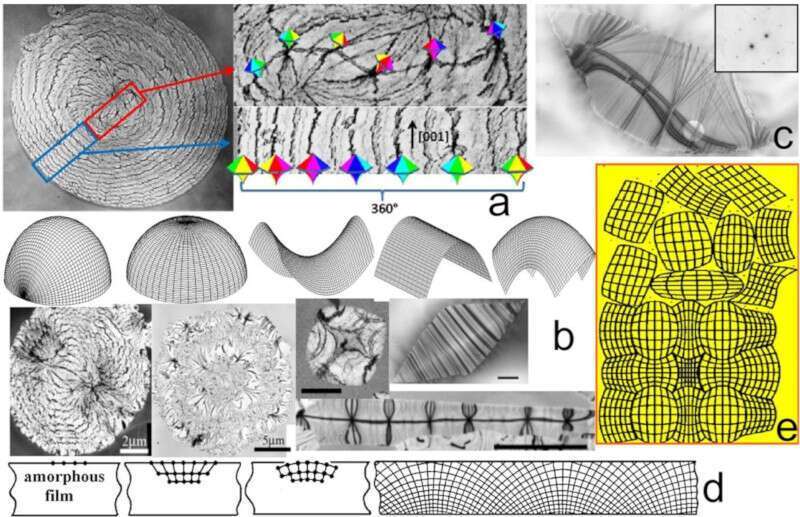
Novel type of bent-lattice nanostructure in crystallizing amorphous films revealed by TEM: From transrotational crystals to novel amorphous models
Exotic thin crystals with unexpected transrotational nanostructures [1] have been discovered by transmission electron microscopy (TEM) for crystal growth in thin (10-100 nm) amorphous films of different chemical nature (Se, Te and chalcogenides, pnictides, silicides, some metals and oxides incuding PZT and STO) prepared by various methods.
The unusual phenomenon often can be observed in situ in TEM column during local e-beam heating or annealing: regular internal bending of crystal lattice planes in a growing crystal, Fig.1a-b. It is dislocation independent. Such transrotation (translation of the unit cell is complicated by small rotation realized round an axis lying in the film plane) can result in strong regular lattice orientation gradients (up to 300 degrees/µm) of different geometries: cylindrical, ellipsoidal, toroidal, saddle, etc., Fig.1b
The possible mechanisms of the phenomenon are discussed. Fig.1d. Initial amorphous state and surface nucleation of the crystal growth are most essential factors. The last fact accompanied by anisotropy of crystal growth rate and obvious tendency for regular change of interatomic distances of the crystal propagating from the surface layers inside the bulk material result in transrotational nanostructure. The phenomenon is the basis for novel lattice- rotation nanoengineering of functional, smart thin-film materials suitable also for strain nanoengineering. Transrotational micro crystals have been eventually recognized by different authors in some thin film materials vital in applications, e.g. phase change materials (PCM) for memory [3-5].
New nanocrystalline concept for the models of amorphous state are proposed: fine-grained structures with lattice curvature, Fig.1e.
[1] V.Yu.Kolosov, A.R.Tholen, Acta Mater. 48 (2000) 1829-1840.
[2] I.E.Bolotov, V.Yu.Kolosov, Phys.Stat.Sol. 69a (1982) 85-96.
[3] B.J.Kooi, J.T.M.DeHosson, J.App.Phys. 95 (2004), 4714-4721.
[4] J.Kalb et al., J.Appl.Phys. 98 (2005), 054902
[5] E.Rimini et al, J.App.Phys. 105 (2009), 123502.

Fig.1. TEM of thin crystals grown in amorphous films (a, b) with crystal lattice planes curvature shown (b, upper row), and Se “transrotational” single crystal with SAED (c); growth model (d); new concept for the nanocrystalline amorphous models (crystal clusters with curved lattice) (e).
Powered by Eventact EMS